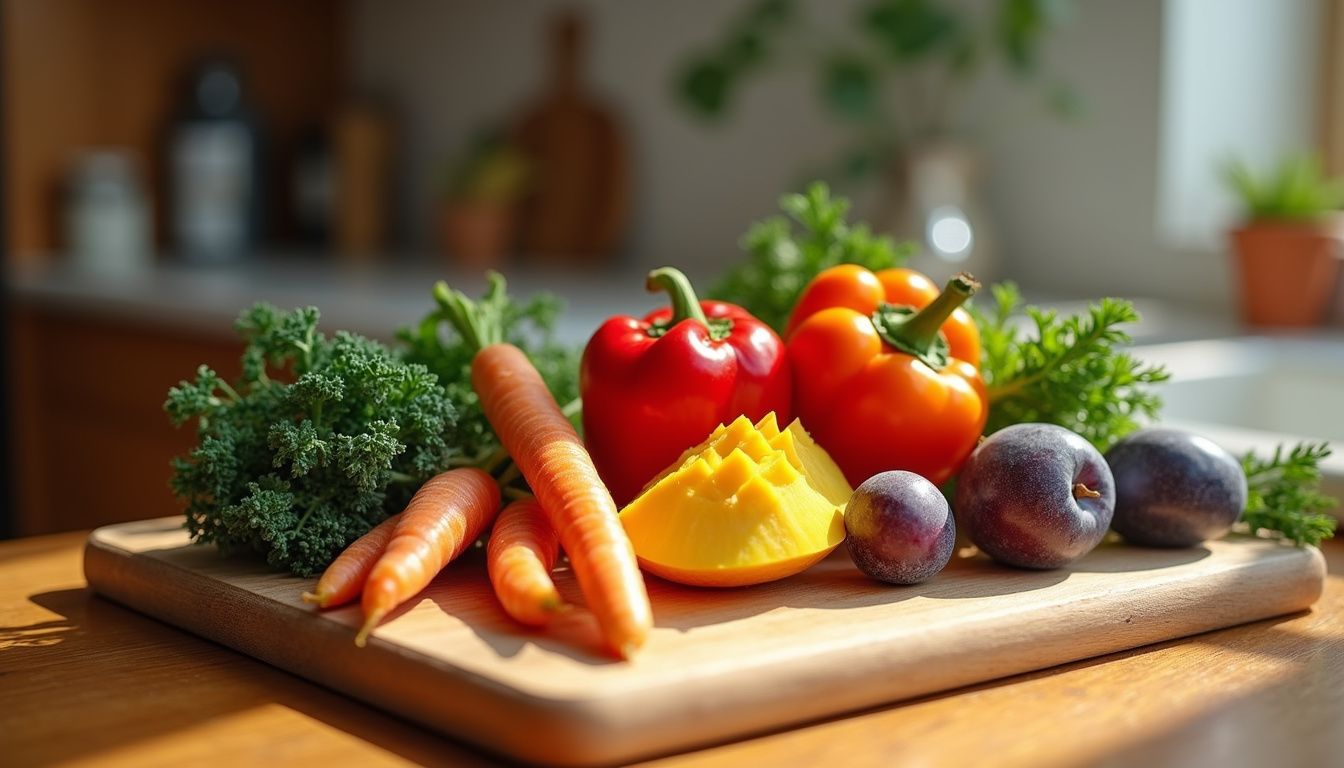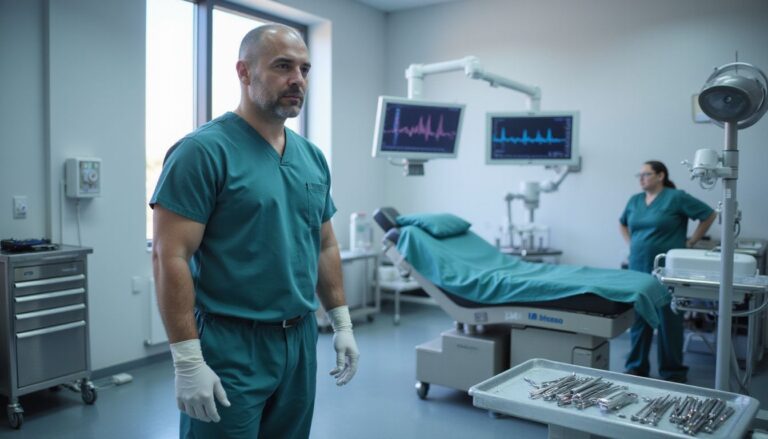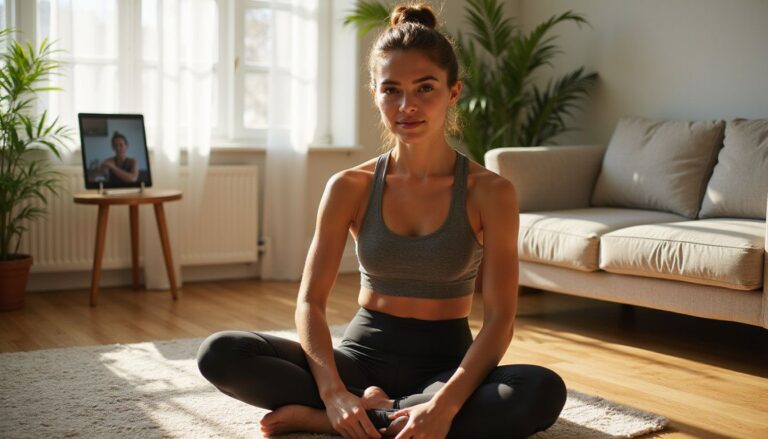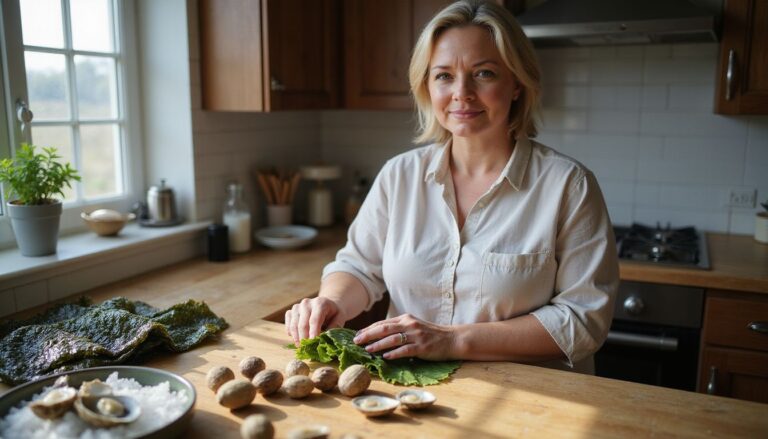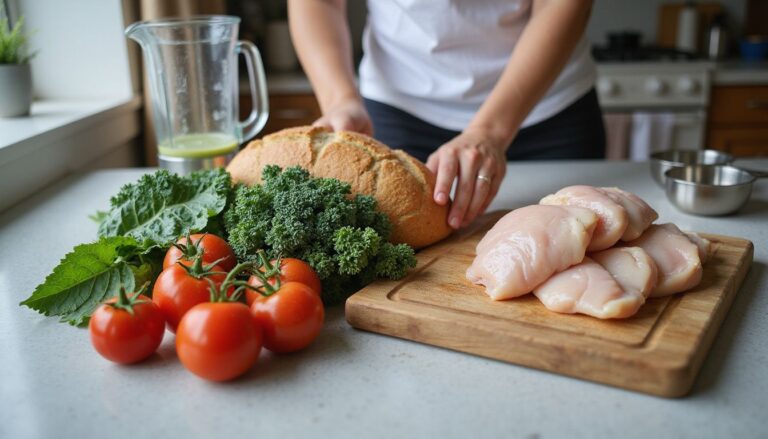Essential Nutrition For Healthy Eyes: Eye Health Tips From The American Academy Of Ophthalmology
Our Nutrition Assistant AI Suite will transform your body. You will lose fat, get toned, and build muscle. Gain confidence and optimal health.
Worried about blurry vision or tired eyes? Your daily diet has a direct impact on eye health. The American Academy of Ophthalmology highlights key nutrients that help protect your sight, especially as you age.
Vitamins A, C, and E, plus zinc, lutein, zeaxanthin, and omega-3 fatty acids, support the retina and macula. Research from the Age-Related Eye Disease Studies (AREDS and AREDS2) links these nutrients to a lower risk of age-related eye problems. Small changes at the table can support sharper vision for years.
This guide shares practical tips backed by reliable studies. Healthy eyes start with what you eat, so keep reading to see how your choices can boost eye health.
Key Takeaways
- Eating foods rich in vitamin A, C, E, lutein, zeaxanthin, zinc, and omega-3s is linked to a lower risk of cataracts and age-related macular degeneration, up to 33% in AREDS research.
- The American Academy of Ophthalmology suggests leafy greens, fatty fish such as salmon or sardines twice weekly, nuts for vitamin E, citrus fruit for vitamin C, and whole grains daily.
- Limiting processed foods high in unhealthy fats can reduce inflammation that contributes to diabetic retinopathy and vision loss, according to National Eye Institute guidance.
- Regular eye exams catch diseases like glaucoma and AMD early, often before symptoms, which can prevent permanent vision loss with timely care.
- Combined nutrients, such as lutein, zeaxanthin, vitamins C, E, and A, plus minerals like zinc and selenium, show stronger protection for the retina than single supplements alone in AREDS2.
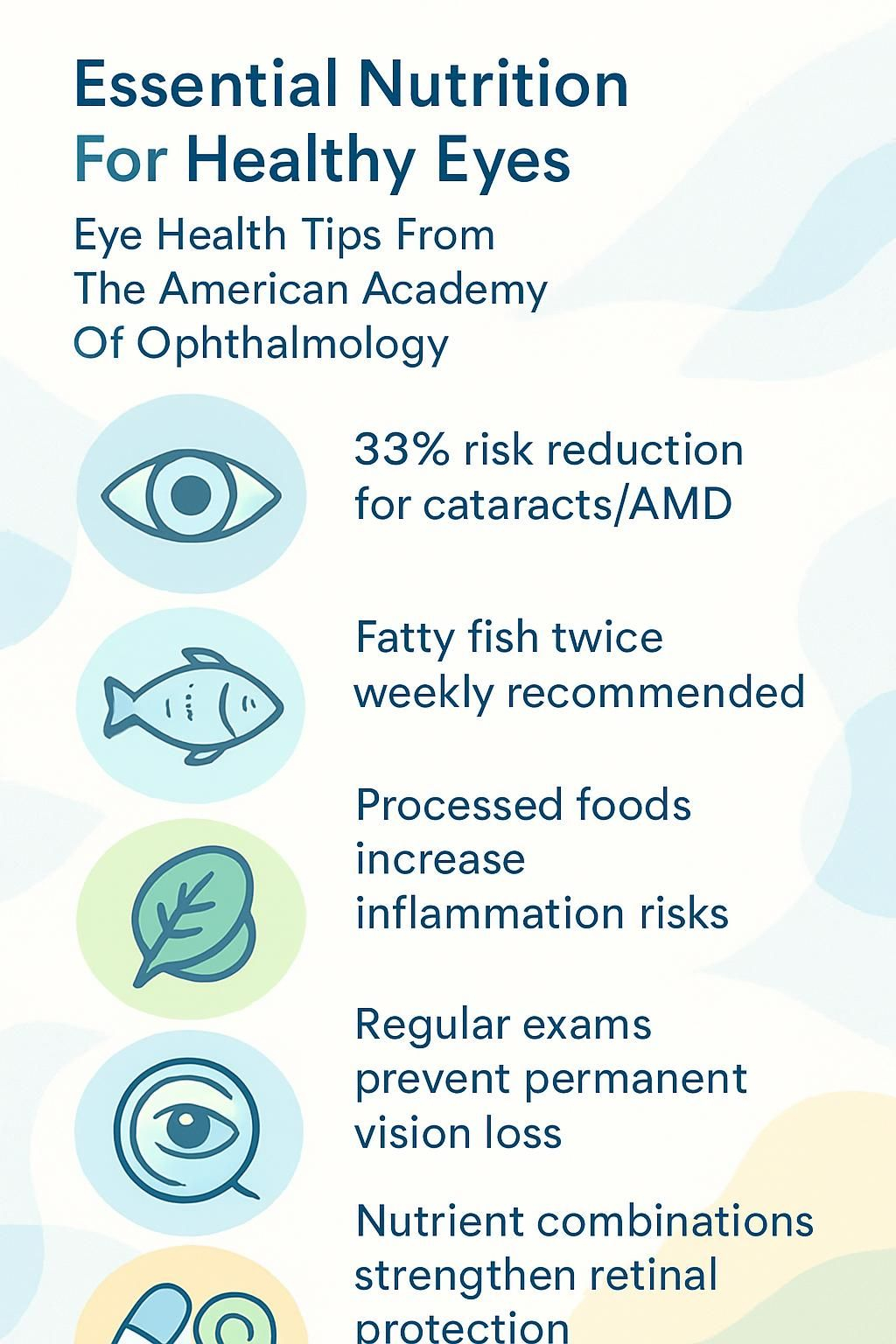
Why Is Nutrition Important for Eye Health?

Your eyes need steady nutrition to function well. Vitamins and minerals support the retina and macula, the delicate eye tissues that help you see detail and color. Vitamin A supports night vision and helps prevent dry eye.
Lutein, zeaxanthin, zinc, omega-3s, and vitamin C may lower the risk of age-related macular degeneration and cataracts. Colorful fruits and vegetables, such as spinach, kale, broccoli, oranges, and bell peppers, supply antioxidants that neutralize free radicals.
I added leafy greens to dinner most nights and noticed less eye strain during evening reading. The AREDS research shows certain supplements can slow AMD progression by up to 25% in people at risk.
“Nutrition is an important factor for maintaining good ocular health throughout life,” says the National Eye Institute.
Choosing nutrient-dense foods supports eye comfort now and preserves your vision as you age.
Essential Vitamins for Healthy Eyes
Specific vitamins help keep vision sharp. These nutrients support the cornea, lens, and retina and may reduce the risk of chronic eye disease.
How Does Vitamin A Support Night Vision and Corneal Health?
Vitamin A is vital for night vision. Your retina uses vitamin A to make rhodopsin, a light-sensitive pigment that works in low light. Low vitamin A can cause poor dark adaptation and night blindness.
This vitamin also supports a healthy cornea by keeping the eye surface moist. Food sources include liver, eggs, spinach, sweet potatoes, carrots, and papaya. The World Health Organization notes that lack of vitamin A is a leading cause of preventable childhood blindness worldwide.
Regular intake helps with normal tear production and protects sensitive eye tissues. Aim to include a source daily, especially if you notice dry eye symptoms.
What Are the Benefits of Vitamin C for Eye Protection and Cataracts?
Vitamin C is a strong antioxidant that protects eye cells from free radicals. Citrus fruits, berries, and leafy greens are reliable sources. In AREDS2 and other studies, higher vitamin C intake was associated with lower cataract risk, in some reports up to 33%.
Getting about 500 mg per day from food and supplements, along with other nutrients, may also help slow AMD progression. Vitamin C supports healthy blood vessels in the retina and helps maintain a clear lens.
As Dr. Emily Chew notes from the National Eye Institute,
“A healthy diet rich in vitamin C may reduce cataract formation and protect long-term vision.”
Adding oranges, strawberries, and peppers is an easy place to start.
How Does Vitamin E Protect Eye Cells from Damage?
Vitamin E helps shield eye cells from oxidative damage. It works as an antioxidant that protects the retina from unstable molecules called free radicals. Adequate intake is linked to a lower risk of age-related macular degeneration.
Good sources include almonds, sunflower seeds, and vegetable oils such as sunflower or olive oil. Snacks with nuts and seeds make it simple to reach your daily goal.
Vitamin E Content, Common Foods
| Food Source | Vitamin E |
|---|---|
| Almonds (1 oz) | 7.3 mg |
| Sunflower seeds (1 oz) | 7.0 mg |
| Olive oil (1 tbsp) | 1.9 mg |
| Spinach, cooked (1/2 cup) | 1.9 mg |
Key Carotenoids for Eye Protection
Carotenoids are natural plant pigments. In the eye, they help filter harmful light and protect the macula.
How Do Lutein and Zeaxanthin Protect Against Harmful Blue Light?
Lutein and zeaxanthin concentrate in the macula, the center of your retina. They act like internal sunglasses. These pigments absorb high-energy blue light from screens and sunlight, which eases stress on photoreceptor cells.
People with higher intakes of these carotenoids tend to have better macular health. Great choices include kale, spinach, collards, and egg yolks. Aim for a daily serving of leafy greens to support visual performance.
What Role Does Beta-Carotene Play in Retina Health?
Beta-carotene is a precursor to vitamin A. Your body converts it into vitamin A, which helps make rhodopsin, a pigment needed for night vision. Carrots, sweet potatoes, spinach, kale, and tomatoes are rich sources.
Consistent intake supports the retina and may lower the risk of AMD and other retinal problems. People who eat plenty of orange and dark green vegetables often report better night driving comfort.
Beta-Carotene per 100 g, Popular Foods
| Food Source | Beta-Carotene |
|---|---|
| Carrots | 8,285 mcg |
| Sweet potatoes | 9,440 mcg |
| Spinach | 5,626 mcg |
| Kale | 9,226 mcg |
The Role of Minerals in Eye Health
Minerals support visual pigments and protect the retina. Two standouts are zinc and selenium.
How Does Zinc Support Visual Pigments and Retina Function?
Zinc is involved in making melanin, a pigment that protects eye cells from light damage. It also helps vitamin A form rhodopsin for low-light vision. Low zinc can lead to poor night vision.
Red meat, poultry, beans, whole grains, and nuts provide zinc. In AREDS, zinc helped slow vision loss in people with intermediate AMD. Include zinc-rich foods in meals to support clear vision in both bright and dim light.
Can Selenium Help Prevent Age-Related Macular Degeneration (AMD)?
Selenium acts as an antioxidant partner for vitamins C and E. Low selenium levels are linked with higher AMD risk in some studies. It supports the body’s defense against oxidative stress in eye tissues.
Food sources include Brazil nuts, seafood, eggs, and whole grains. A Mediterranean-style eating pattern often supplies selenium along with omega-3 fats for extra support.
Essential Fatty Acids for Vision Support
Essential fatty acids help calm inflammation and support a stable tear film. They are key for eye comfort during long screen time.
How Do Omega-3 Fatty Acids Reduce Dry Eyes and Inflammation?
Omega-3 fatty acids, especially EPA and DHA from fatty fish and fish oil, support the oily layer of the tear film. This helps reduce dryness, burning, and redness. These fats also lower inflammatory signals in eye tissues.
Salmon, sardines, trout, mackerel, and tuna are solid choices. Plant sources like walnuts and chia seeds provide ALA, a plant omega-3. I added salmon twice weekly and noticed fewer dry eye symptoms during long workdays.
What Is the Benefit of Gamma-Linolenic Acid (GLA) for Tear Quality?
Gamma-linolenic acid is an omega-6 fatty acid that can improve tear quality for some people with dry eye. Studies using 240 to 600 mg of GLA daily for about three months show better tear volume and stability.
Evening primrose oil, borage oil, and black currant seed oil contain GLA. Talk with your clinician before starting, especially if you take blood thinners or have chronic conditions.
The Mediterranean Diet and Eye Health
This eating pattern centers on plants, fish, and healthy oils, a simple template that also feeds your eyes.
What Foods in the Mediterranean Diet Support Eye Health?
Leafy greens, colorful produce, nuts, seeds, whole grains, and fatty fish work together to protect vision. Spinach, kale, oranges, and strawberries supply lutein, zeaxanthin, and vitamin C. Walnuts, almonds, and sunflower seeds add vitamin E and healthy fats.
Olive oil supports cell membranes in eye tissues. Lentils, beans, and seafood provide zinc and selenium. After shifting meals toward this pattern, I had fewer bouts of eye dryness during long computer sessions.
How Do Whole Grains and Fruits Benefit Vision?
Whole grains have a lower glycemic index, which supports long-term retinal health. B vitamins in whole grains, such as niacin, help protect nerve cells that process visual signals.
Fruits like oranges and strawberries provide vitamin C for lens and cornea support. Swapping white bread for oatmeal and adding a daily orange is a simple way to help your eyes and energy levels.
Foods That Boost Eye Health
Build your plate with foods that deliver vitamins, minerals, and antioxidants. The goal is variety across the week.
Which Leafy Greens Are Best for Eye Health?
Leafy greens supply key carotenoids and vitamins that support long-term vision. Rotate several types to cover your bases.
- Spinach is rich in lutein and zeaxanthin, which help filter blue light and may lower AMD risk.
- Kale is a top source of lutein and also provides vitamin C, which supports lens clarity.
- Collard greens offer vitamin A, vitamin C, and antioxidants that protect eye cells.
- Swiss chard contains vitamin E and beta-carotene that support the cornea and night vision.
- Romaine lettuce is easy to use in salads and provides beta-carotene for vitamin A production.
- Turnip greens add vitamin C and minerals that support healthy blood flow to the eyes.
- Arugula supplies plant compounds that help calm low-grade inflammation in eye tissues.
Choices rich in vitamins C and E, plus carotenoids, strengthen your defense against high-energy visible light.
What Types of Fish Support Vision?
Fish provide omega-3s, protein, and minerals that support the retina and tear film. Include a mix across the month.
- Salmon offers abundant omega-3s that reduce retinal inflammation and support tear quality.
- Sardines supply vitamin D and selenium, nutrients linked to lower AMD risk.
- Mackerel delivers concentrated omega-3s that nourish retinal cells.
- Tuna provides protein, zinc, and omega-3s, which may ease dry eye symptoms.
- Trout adds vitamin A precursors that support night vision and corneal health.
- Herring offers vitamin E and omega-3s that protect cell membranes from oxidative damage.
- Anchovies pack minerals and essential fats in small servings.
- Halibut provides lean protein and omega-3s that support overall eye function.
Including salmon or sardines twice a week is a practical step with strong nutrition impact.
How Do Citrus Fruits Help Protect Your Eyes?
Citrus fruit and berries help protect the lens and retina. Their vitamin C supports collagen and antioxidant defenses.
- Vitamin C helps shield eye cells from oxidative stress caused by free radicals.
- Healthy retinal blood vessels rely on vitamin C, which may lower cataract risk with age.
- Oranges and strawberries support corneal collagen, which helps maintain a clear surface.
- Higher vitamin C intake is linked with slower AMD progression in some studies.
- Adding citrus to water helps hydration, which supports tear production.
- Vitamin C can improve absorption of minerals such as iron and zinc.
- Stronger immune support may reduce infections that could affect vision.
- Daily citrus is a simple way to raise intake of eye-protective nutrients.
- Ascorbic acid, the form of vitamin C, has strong antioxidant activity.
- Fruit salads with oranges and berries deliver nutrients without excess added sugar.
What Nuts and Seeds Are Good for Eye Nutrition?
Nuts and seeds deliver vitamin E, minerals, and healthy fats that protect delicate eye tissues.
- Almonds provide vitamin E for antioxidant protection. One ounce offers about half the daily target.
- Walnuts are rich in omega-3s that support retinal function.
- Chia seeds supply plant omega-3s and antioxidants that may calm inflammation.
- Sunflower seeds deliver vitamin E and selenium, important for lens and retinal health.
- Flaxseeds provide omega-3s and lignans that support tear quality.
- Pumpkin seeds add zinc, which helps visual pigment formation.
- Pistachios contain lutein and zeaxanthin that filter blue light.
- Brazil nuts are a top source of selenium for oxidative defense.
- Cashews contribute copper for collagen strength around the cornea.
The Role of Antioxidants in Eye Disease Prevention
Antioxidants help control oxidative stress, one driver of damage to the lens and retina.
How Can Antioxidants Slow Age-Related Macular Degeneration?
Vitamins C and E, plus beta-carotene and other carotenoids, protect retinal cells from free radicals. In AREDS, people at risk who took a proven mix of antioxidants and zinc cut the chance of advanced AMD by about 25% over five years.
Foods like spinach, bell peppers, nuts, and strawberries provide these nutrients. A steady supply lowers inflammation and supports macular function.
Do Antioxidants Help Reduce the Risk of Cataracts?
Higher intakes of vitamin C, vitamin E, and carotenoids are associated with a lower risk of cataracts in many studies. One study found up to a 33% reduction in cataract progression over ten years with vitamin C-rich diets.
Build a routine with citrus fruit, berries, leafy greens, and nuts. Your eyes benefit, and so does your general health.
Benefits of Dietary Supplements for Eye Health
Supplements can help when your diet falls short. Food should come first, then targeted supplements if needed.
When Should You Use Supplements to Fill Nutritional Gaps?
Supplements are helpful if you avoid certain foods, have absorption issues, or follow restricted diets. People who rarely eat fish may need omega-3s. Vegetarians and vegans may need extra zinc or vitamin B12.
Blood tests can confirm low levels of zinc, vitamin A, or vitamin D. If you notice new dry eye or night vision issues, discuss supplements with your eye care professional. Always review possible interactions with your healthcare team before starting.
How Do Combined Nutrients Improve Eye Health Results?
Combinations tend to work better than single nutrients. The AREDS and AREDS2 formulas use lutein, zeaxanthin, vitamins C and E, zinc, and copper to support macular health.
A diet that mixes carotenoids, vitamins, and healthy fats often delivers the best results. Leafy greens, fish, citrus fruit, and nuts make a strong daily foundation.
How Can You Maintain a Balanced Diet for Better Vision?
A balanced plate provides steady energy and steady eye support. Think plants first, then add protein and healthy fats.
Why Limit Processed Foods and Unhealthy Fats?
Processed snacks and fried foods raise inflammation that can harm the retina. Trans fats and excess saturated fat may narrow blood vessels and reduce blood flow to the eyes.
These foods also replace nutrient-rich choices, such as greens, fish, nuts, and fruit. I felt less dryness after cutting back on packaged snacks and choosing oatmeal, berries, and grilled fish instead.
How to Increase Nutrient-Dense Food Intake for Eye Health?
- Choose dark leafy greens like spinach, kale, and collards for lutein and zeaxanthin.
- Eat fatty fish such as salmon, sardines, or mackerel twice per week for omega-3s.
- Snack on almonds, walnuts, or chia seeds to add vitamin E and healthy fats.
- Add oranges, grapefruit, and berries for a vitamin C boost that may slow cataract formation.
- Pick whole grains such as brown rice, quinoa, or whole wheat bread for B vitamins and minerals.
- Drink water often to support tear production and eye comfort.
- Limit sugary drinks, fried items, and heavily processed snacks to reduce inflammation.
- Cook at home more often to control portions and ingredients.
- Check with your clinician if you have dietary restrictions or chronic conditions.
- Join local classes or programs that teach easy, vegetable-forward recipes.
- Track meals for a week, then add nutrient-rich swaps where you see gaps.
Eye Health Tips from the American Academy of Ophthalmology
The AAO advises a prevention mindset. Think of these steps as daily eye safety.
Why Are Regular Eye Exams Important for Early Detection?
Eye exams can find glaucoma, diabetic retinopathy, and AMD before you notice symptoms. Early treatment prevents vision loss in many cases. Exams also reveal signs of high blood pressure and diabetes.
Schedule routine visits with an ophthalmologist or optometrist to track changes and act quickly if needed.
How Can You Protect Your Eyes from UV and Blue Light?
Wear sunglasses that block 100% of UVA and UVB. A wide-brimmed hat adds another layer outdoors. Look for UV400 labels on lenses.
Use blue light filters on screens and follow the 20-20-20 rule. Every 20 minutes, look at something 20 feet away for 20 seconds. I switched to prescription lenses with blue light coating and noticed fewer headaches.
How Does Staying Hydrated Support Tear Production?
Water helps your eyes make tears. Without enough fluid, eyes feel gritty and vision can blur.
The AAO suggests drinking water throughout the day to support a healthy tear film. Aim for at least eight cups daily, and more if you use screens for long periods or live in a dry climate.
Additional Lifestyle Habits for Eye Health
Daily habits shape eye comfort and long-term vision. Small steps add up.
How Does Regular Exercise and Healthy Weight Benefit Eyes?
Exercise improves blood flow, bringing oxygen and nutrients to the eyes. It also helps manage blood pressure and cholesterol, two factors tied to AMD and diabetic retinopathy.
Keeping a healthy weight reduces inflammation and eye pressure. Even brisk walking, swimming, or cycling can support vision and general health.
Why Should You Avoid Smoking to Protect Your Vision?
Smoking increases the risk of AMD and cataracts. Toxins in smoke damage blood vessels and lower antioxidant levels in the eye.
Quitting at any age reduces risk. I watched relatives recover eye comfort after quitting, a change that stalled further decline.
When Should You Consult an Eye Care Professional?
Do not wait on sudden changes. Timely care protects sight.
How Do You Know When to See an Ophthalmologist?
Seek care right away for sudden blur, flashes, new floaters, eye pain, redness, or swelling. These may signal an urgent problem.
If you have diabetes or a family history of glaucoma or AMD, schedule regular exams. If reading or driving becomes difficult, make an appointment soon.
What Are Personalized Dietary Recommendations for Eye Health?
Personalized plans consider age, health history, and eating patterns. A clinician or dietitian may suggest higher intakes of lutein, zeaxanthin, or omega-3s if you have AMD risk or dry eye.
Supplements are recommended only when food alone cannot meet goals. The aim is practical habits that support lifelong vision.
What Are Common Myths About Eye Health and Nutrition?
Misunderstandings are common. Clear facts help you make better choices.
Is It True That Carrots Improve Vision?
Carrots provide beta-carotene, which your body converts into vitamin A. Adequate vitamin A supports night vision and a healthy cornea. If you already meet your needs, extra carrots will not make perfect vision sharper.
Carrots help prevent deficiency. For full protection, eat a variety of colorful fruits and vegetables.
What Are the Limitations of Eye Health Supplements?
Supplements cannot replace a balanced diet. AREDS2 formulas helped people with intermediate AMD, but they did not prevent AMD in healthy adults. High doses can interact with medicines or cause side effects.
Food-first works best. I saw more comfort after adding greens and fish than from pills alone. Discuss any supplement with your healthcare provider.
Conclusion
Protecting your sight starts on your plate. Focus on leafy greens, fatty fish, nuts, whole grains, and colorful fruit to supply vitamin C, vitamin E, zinc, lutein and zeaxanthin, and omega-3 fatty acids. These choices support eye health and may reduce the risk of AMD and cataracts.
Pair smart eating with regular eye exams, UV protection, and good hydration. This article is educational and not medical advice. For personal guidance, consult an eye care professional. Small steps today can help you see clearly tomorrow.
FAQs
1. What nutrients are most important for healthy eyes according to the American Academy of Ophthalmology?
Vitamins A, C, and E; zinc; lutein; zeaxanthin; and omega-3 fatty acids support eye health. Research shows these nutrients help protect against age-related vision loss and other common eye problems.
2. Which foods provide essential nutrition for healthy eyes?
Leafy greens like spinach, kale, and collard greens offer high levels of lutein and zeaxanthin. Fish such as salmon or sardines supply omega-3s. Carrots contain vitamin A while citrus fruits deliver vitamin C.
3. How does diet affect long-term vision health?
A balanced diet with key vitamins and minerals helps reduce the risk of cataracts and macular degeneration over time. Studies published in peer-reviewed journals confirm that people who eat nutrient-rich diets have better visual outcomes as they age.
4. Can personal habits improve eye health along with proper nutrition?
Yes, combining a nutritious diet with regular exercise, not smoking, wearing sunglasses outdoors, and getting routine eye exams can further protect your eyesight throughout life.
Summary: Eating foods rich in specific vitamins and minerals supports lifelong vision wellness according to evidence from the American Academy of Ophthalmology. Healthy eating combined with good lifestyle choices offers strong protection for your eyes based on current research findings.

